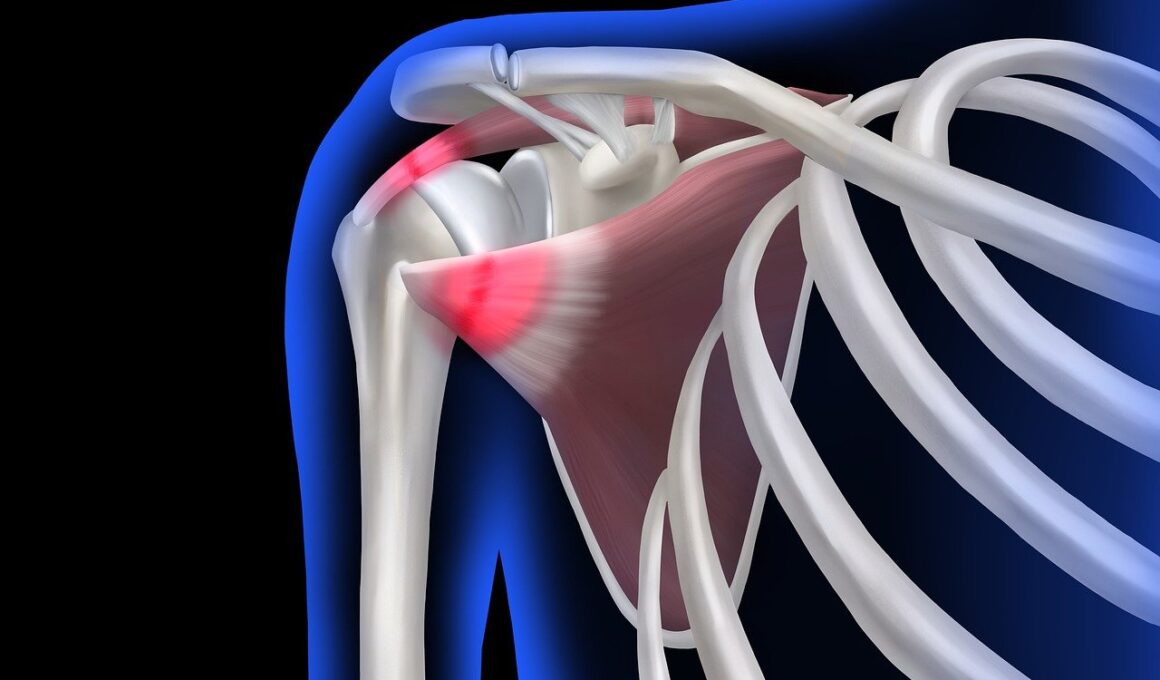Shoulder Injury Prevention Techniques for Bodybuilders
Bodybuilders often face a range of shoulder injuries due to the significant stress placed on this joint during weightlifting sessions. To minimize the risk of injury, bodybuilders should integrate preventive practices into their training regimens. First, understanding the anatomy of the shoulder is essential. This includes knowledge of the rotator cuff, which stabilizes the shoulder joint and helps facilitate movement. Strengthening exercises targeting this area are crucial. Moreover, bodybuilders should focus on enhancing flexibility through regular stretching routines. This practice promotes a full range of motion and reduces tightness in the muscles, which can contribute to injuries. It’s advisable to engage in dynamic stretching before workouts and static stretching afterward. Another effective strategy is to warm up properly before lifting weights. This not only prepares the muscles but also increases blood flow, making the shoulders more resilient. Lastly, bodybuilders should pay attention to their lifting technique. Using proper form reduces unnecessary strain on the shoulders, significantly decreasing the risk of injury. By adhering to these techniques, one can safeguard their shoulders and continue their bodybuilding journey safely.
Implementing Strengthening Exercises
Strengthening exercises play a vital role in shoulder injury prevention for bodybuilders. These exercises are specifically designed to enhance the stability and strength of the shoulder joint and surrounding muscles. Incorporating exercises such as rotator cuff external rotations helps to strengthen the small muscles that stabilize the shoulder joint. Additionally, overhead presses with lighter weights can gradually build strength while ensuring proper form is maintained. A common mistake is to use excessively heavy weights that compromise form. Resistance bands are also excellent tools for shoulder rehabilitation and prevention, allowing for controlled movements that promote muscle engagement without excessive strain. Bodybuilders should aim for at least two to three sessions per week dedicated to shoulder strengthening. Furthermore, focusing on unilateral exercises, like single-arm dumbbell presses, can improve balance and address strength imbalances between both shoulders. Implementing these strengthening exercises consistently provides a foundation for healthier shoulders. Lastly, it’s also beneficial to assess individual limits and adjust routines accordingly, ensuring that one does not overreach beyond their capacity, which would risk injury rather than prevent it.
In addition to strengthening, integrating flexibility workouts into a shoulder regimen is paramount. Muscular tightness can be a significant contributor to shoulder injuries. To combat this, practicing shoulder-specific stretches such as the cross-body shoulder stretch can enhance flexibility and range of motion. Hold each stretch for at least 30 seconds to allow proper muscle elongation. Foam rolling can also alleviate muscle tension and improve blood flow to the area, making it easier to perform lifting movements. In contrast, neglecting flexibility can result in limited joint mobility. Additionally, bodybuilders might consider participating in yoga classes focused on shoulder mobility, which can bolster both flexibility and muscle awareness. Another targeted approach is incorporating dynamic warm-ups, such as arm circles, to prepare the shoulder muscles before heavy lifting. Recognizing the importance of post-workout recovery routines can also significantly contribute to long-term shoulder health. Utilizing ice and proper nutrition after workouts promotes recovery, minimizing inflammation that can lead to injuries. Hence, a combination of strengthening and flexibility should be pivotal in every bodybuilder’s strategy to prevent shoulder problems.
The Role of Proper Form and Technique
Proper form and lifting technique are fundamental in preventing shoulder injuries, especially in bodybuilding. Many injuries occur because lifters ignore correct mechanics while focusing solely on lifting heavier weights. Therefore, learning the correct technique for various exercises is crucial. For instance, when performing bench presses or shoulder presses, it’s essential to keep a neutral wrist and avoid flaring elbows excessively. This helps distribute the weight more effectively across the muscles. Furthermore, utilizing mirrors in the gym can assist bodybuilders in checking their form during workouts. Adopting a slow and controlled movement pattern rather than a rapid forceful one also mitigates injury risk. Additionally, understanding personal limits helps in selecting suitable weights and avoiding overexertion. Incorporating regular form check-ups with a coach, especially for exercises putting the shoulder under stress, can enhance safety. If unsure about a lift, using lighter weights while perfecting technique is always wise. Furthermore, muscle fatigue can impair form significantly; therefore, taking planned breaks during workouts is necessary to maintain proper technique. In summary, committing to proper form is foundational for injury prevention in bodybuilding.
Listening to Body Signals
Listening to the body is an often ignored yet critical component of shoulder injury prevention. Bodybuilders need to be acutely aware of any early signs of discomfort or pain in the shoulder region. Ignoring pain can lead to more severe injuries, potentially sidelining one’s bodybuilding journey. Early detection of discomfort enables bodybuilders to assess and adjust training routines accordingly. Engaging in self-check-ins during and after workouts helps identify any unusual sensations in the shoulder muscles or joints. If stiffness or pain arises, it’s wise to modify the workout to target less intense movements for a time. Furthermore, implementing scheduled rest days is essential for recovery and ensuring healthy muscle functioning. Consult with a health professional if persistent pain occurs; they can provide expert advice on strength training modifications. Seeking professional guidance can open doors for safe exercises suited for one’s recovery journey. Lastly, encourage bodybuilders to remain patient since rushing back into high-intensity workouts can exacerbate injuries. By prioritizing body signals and rest, one ensures long-lasting success in bodybuilding while minimizing the possibility of shoulder injuries.
In the realm of bodybuilding, maintaining an overall balanced approach toward fitness is crucial for shoulder health. Bodybuilders should not solely focus on upper body strength but consider the entire body’s musculature. Exercises like squats and deadlifts engage various muscle groups, promoting functional strength and stability. Such full-body exercises contribute positively to core strength, which supports the shoulder girdle. Engaging in Pilates or similar workouts that emphasize overall body training can also enhance shoulder strength. Incorporating cross-training, which includes various activity forms, allows for muscle recovery while maintaining cardiovascular fitness. By veering from routine, bodybuilders can decrease the risk of repetitive strain injuries resulting from overuse of the shoulder region. Therefore, a diverse training regimen ensures balanced muscular development and promotes overall athletic performance. Additionally, regularly updating and modifying workout plans keeps athletes motivated while addressing different strengths and weaknesses. Lastly, keep hydration and nutrition in mind as they are integral in enhancing muscle recovery and performance. Thus, an all-rounded approach focusing on various physical aspects ensures a foundation not only for bodybuilding success but also for sustainable shoulder health.
Final Thoughts on Injury Prevention
Preventing shoulder injuries in bodybuilding requires commitment and a multifaceted approach to training. Balancing strengthening exercises with flexibility and proper technique cultivates better muscle health and joint stability. The education of lifting mechanics cannot be understated, as it shapes muscle functioning during workouts. Regular check-ins and adjustments further aid in heightening awareness of one’s body signals. This approach can mean the difference between pushing through pain and addressing issues before they escalate. Similarly, embracing a diverse training approach, which involves cross-training and full-body workouts, not only keeps things interesting but enhances overall performance. Moreover, lifelong learning about advancements in injury prevention research can also empower bodybuilders in maintaining shoulder health. Staying informed allows athletes to adapt techniques based on the latest findings in fitness research. Ultimately, the initiation of these prevention techniques is essential in contributing not only to improved bodybuilding performance but also in safeguarding one’s training future. Prioritizing shoulder health means ensuring a long, versatile, and injury-free bodybuilding career, setting the stage for continuous personal growth in the sport.


